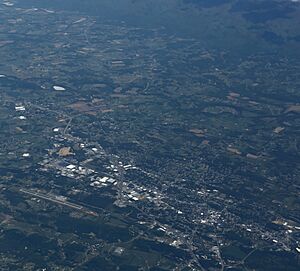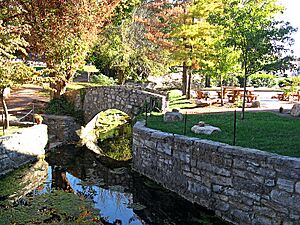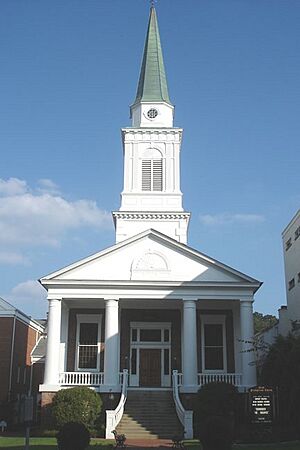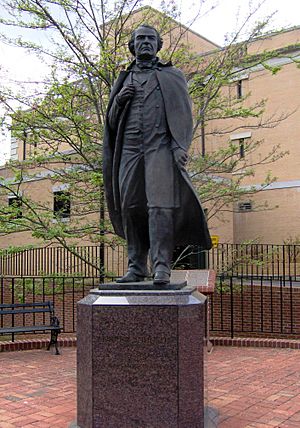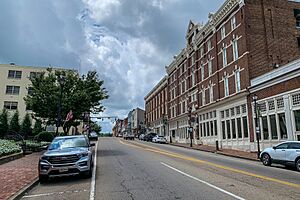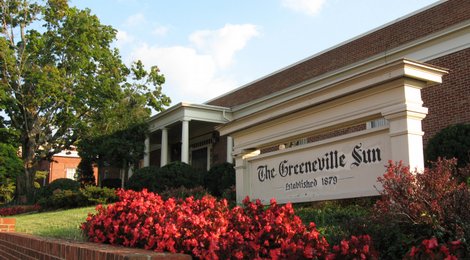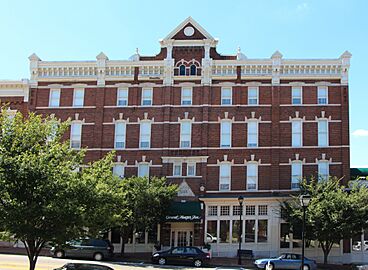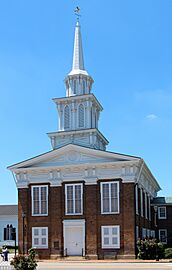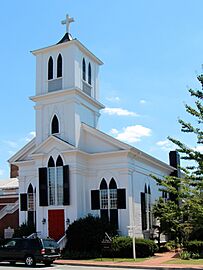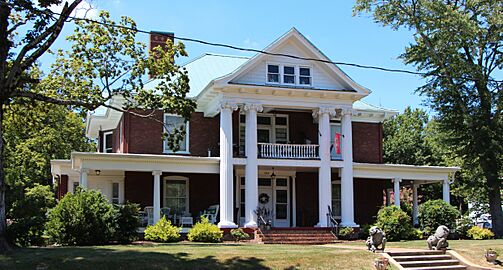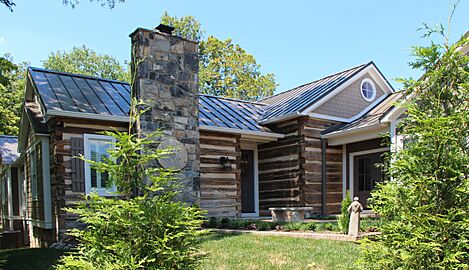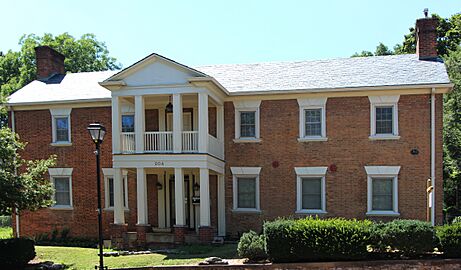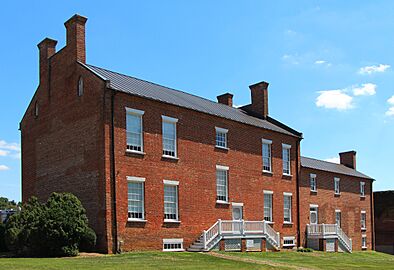Greeneville, Tennessee facts for kids
Quick facts for kids
Greeneville
|
|||
|---|---|---|---|
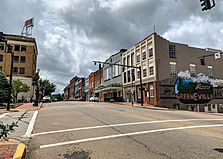
Corner of Main and Depot in downtown Greeneville
|
|||
|
|||
| Nickname(s):
Home of President Andrew Johnson
|
|||

Location of Greeneville in Greene County, Tennessee.
|
|||
| Country | United States | ||
| State | Tennessee | ||
| County | Greene | ||
| Settled | 1780 | ||
| Founded | 1783 | ||
| Incorporated | 1795 | ||
| Named for | Nathanael Greene | ||
| Government | |||
| • Type | Council-Manager | ||
| Area | |||
| • Town | 17.00 sq mi (44.02 km2) | ||
| • Land | 17.00 sq mi (44.02 km2) | ||
| • Water | 0.00 sq mi (0.00 km2) | ||
| Elevation | 1,595 ft (486 m) | ||
| Population
(2020)
|
|||
| • Town | 15,479 | ||
| • Density | 910.69/sq mi (351.63/km2) | ||
| • Urban | 23,664 | ||
| Time zone | UTC-5 (Eastern (EST)) | ||
| • Summer (DST) | UTC-4 (EDT) | ||
| ZIP Codes |
37616, 37743 & 37745 (General Delivery) and 37744 (P.O. Boxes)
|
||
| Area code(s) | 423 | ||
| FIPS code | 47-30980 | ||
| GNIS feature ID | 2406613 | ||
| Website | www.greenevilletn.gov | ||
Greeneville is a town in Tennessee, United States. It is the main town, or county seat, of Greene County. In 2020, about 15,479 people lived there.
The town is named after Nathanael Greene, a hero from the American Revolutionary War. Greeneville is the second oldest town in Tennessee. It's also the only town in the U.S. spelled "Greeneville" with an "e" at the end.
Greeneville was once the capital of the State of Franklin. This was a short-lived independent state in the 1700s.
Later, Andrew Johnson, who became the 17th President of the United States, started his political journey in Greeneville. He was first elected as an alderman (a city council member) here. He was a tailor by trade and lived in Greeneville for most of his adult life. The town was known for its strong views against slavery and for supporting the Union during the Civil War. This environment helped shape Johnson's beliefs.
The Greeneville Historic District was created in 1974 to protect its history. A U.S. Navy submarine, the USS Greeneville, was named after the town. Greeneville is also part of the "Tri-Cities" region in Tennessee.
Contents
- Greeneville's Location and Landscape
- Greeneville's Past: A Look at History
- Early Days and Settlements
- The State of Franklin: A Short-Lived State
- Greeneville and the Fight Against Slavery
- Greeneville During the Civil War
- President Andrew Johnson's Life in Greeneville
- Buffalo Soldiers: Heroes in Greeneville
- George Clem School: A Story of Education
- Magnavox: A Major Employer
- 2011 Tornado Outbreak
- Downtown Greeneville's New Look
- Greeneville's Population and People
- Greeneville's Economy and Jobs
- Arts, Culture, and Fun in Greeneville
- Sports in Greeneville
- Parks and Outdoor Fun
- Education in Greeneville
- Media and News
- Healthcare in Greeneville
- Famous People from Greeneville
- Images for kids
- See also
Greeneville's Location and Landscape
Greeneville is nestled in the foothills of the Appalachian Mountains. These hills are part of a region known for its fertile river valleys and long, narrow ridges. Greeneville sits between Bays Mountain to the northwest and the Bald Mountains to the southeast. The town is in the watershed of the Nolichucky River, which flows a few miles south.
Many important roads meet in Greeneville. These roads follow old trails. U.S. Route 321 goes through the town center. U.S. Route 11E (Andrew Johnson Highway) also passes through Greeneville. Other state routes like Tennessee State Route 107, Tennessee State Route 70, Tennessee State Route 172, and Tennessee State Route 93 connect Greeneville to nearby cities and highways.
The United States Census Bureau says Greeneville covers about 17 square miles (44 square kilometers) of land.
Greeneville's Weather and Climate
| Climate data for Greeneville, Tennessee (1991–2020 normals, extremes 1890–present) | |||||||||||||
|---|---|---|---|---|---|---|---|---|---|---|---|---|---|
| Month | Jan | Feb | Mar | Apr | May | Jun | Jul | Aug | Sep | Oct | Nov | Dec | Year |
| Record high °F (°C) | 79 (26) |
82 (28) |
86 (30) |
90 (32) |
96 (36) |
101 (38) |
104 (40) |
100 (38) |
102 (39) |
95 (35) |
85 (29) |
80 (27) |
104 (40) |
| Mean daily maximum °F (°C) | 47.6 (8.7) |
51.8 (11.0) |
60.1 (15.6) |
69.6 (20.9) |
77.5 (25.3) |
84.2 (29.0) |
87.3 (30.7) |
86.7 (30.4) |
82.1 (27.8) |
71.8 (22.1) |
60.0 (15.6) |
50.8 (10.4) |
69.1 (20.6) |
| Daily mean °F (°C) | 36.6 (2.6) |
40.0 (4.4) |
47.1 (8.4) |
55.9 (13.3) |
64.8 (18.2) |
72.5 (22.5) |
76.1 (24.5) |
74.9 (23.8) |
69.1 (20.6) |
57.7 (14.3) |
46.6 (8.1) |
39.7 (4.3) |
56.8 (13.8) |
| Mean daily minimum °F (°C) | 25.5 (−3.6) |
28.2 (−2.1) |
34.0 (1.1) |
42.2 (5.7) |
52.1 (11.2) |
60.7 (15.9) |
64.9 (18.3) |
63.1 (17.3) |
56.2 (13.4) |
43.6 (6.4) |
33.1 (0.6) |
28.6 (−1.9) |
44.4 (6.9) |
| Record low °F (°C) | −29 (−34) |
−23 (−31) |
−9 (−23) |
16 (−9) |
26 (−3) |
35 (2) |
45 (7) |
40 (4) |
28 (−2) |
14 (−10) |
3 (−16) |
−16 (−27) |
−29 (−34) |
| Average precipitation inches (mm) | 3.52 (89) |
3.80 (97) |
3.96 (101) |
4.36 (111) |
4.34 (110) |
4.26 (108) |
4.96 (126) |
4.44 (113) |
3.04 (77) |
2.70 (69) |
2.95 (75) |
4.06 (103) |
46.39 (1,178) |
| Average snowfall inches (cm) | 2.2 (5.6) |
2.9 (7.4) |
1.4 (3.6) |
0.0 (0.0) |
0.0 (0.0) |
0.0 (0.0) |
0.0 (0.0) |
0.0 (0.0) |
0.0 (0.0) |
0.0 (0.0) |
0.2 (0.51) |
1.0 (2.5) |
7.7 (20) |
| Average precipitation days (≥ 0.01 in) | 12.2 | 12.3 | 13.4 | 12.0 | 12.5 | 12.4 | 13.1 | 11.2 | 9.1 | 8.9 | 10.1 | 12.9 | 140.1 |
| Average snowy days (≥ 0.1 in) | 2.0 | 2.0 | 0.8 | 0.0 | 0.0 | 0.0 | 0.0 | 0.0 | 0.0 | 0.0 | 0.2 | 1.0 | 6.0 |
| Source: NOAA | |||||||||||||
Greeneville has a humid subtropical climate. This means it has hot, humid summers and mild to cool winters. It gets a good amount of rain throughout the year.
Greeneville's Neighborhoods
Greeneville is home to several neighborhoods, including:
- Buckingham Heights
- Cherrydale
- Oak Hills
- Windy Hills
- Harrison Hills
Greeneville's Past: A Look at History
Early Days and Settlements
Long ago, Native Americans hunted and camped in the Nolichucky Valley. This was as early as 10,000 B.C. By the late 1700s, the Cherokee tribe used the valley as their hunting grounds. Greeneville's location was likely a meeting point for two old Native American trails.
European settlers first arrived in Greene County in 1772. A merchant named Jacob Brown leased land from the Cherokee. This area became known as the "Nolichucky Settlement." In 1783, settlers formed a new county, named after Nathanael Greene. The first county court met at Robert Kerr's home near "Big Spring." Kerr donated land for the county seat, and "Greeneville" became an official town in 1786.
The State of Franklin: A Short-Lived State
In 1784, North Carolina gave its western lands, including Greene County, to the U.S. Congress. This meant North Carolina no longer controlled the area. In response, people from Greene and nearby counties decided to form their own state. They met in Jonesborough and later in Greeneville.
They named their new state the State of Franklin, honoring Benjamin Franklin. They asked Congress to join the United States, but their request was denied. Greeneville was named the capital in 1785. The first legislature of Franklin met in a simple log courthouse in Greeneville. However, the State of Franklin soon fell apart, and North Carolina took control again.
Today, there's a replica of the State of Franklin capitol building in Greeneville. It helps people remember this unique part of the town's history.
Greeneville and the Fight Against Slavery
In the early 1800s, Greene County was a strong center for the movement to end slavery. Many Quakers, who were against slavery, moved to the area from Pennsylvania.
One important figure was Elihu Embree. He published the first newspaper in the U.S. that was only about ending slavery, called The Emancipator. After Embree passed away, Benjamin Lundy, another abolitionist, moved to Greeneville in 1822 and continued the fight.
Many Greeneville residents also worked to end slavery. Hezekiah Balch and Samuel Doak, who founded Tusculum College, freed their own slaves. Francis McCorkle, a local pastor, was a leader in the Manumission Society of Tennessee, a group dedicated to freeing slaves.
Greeneville During the Civil War
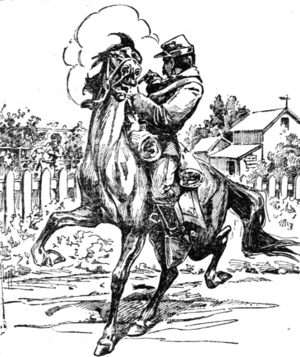
Before the American Civil War began in 1861, many people in East Tennessee, including Greeneville, supported the Union. They wanted to stay with the United States. In June 1861, leaders from East Tennessee met in Greeneville. They hoped to form a separate state that would remain loyal to the Union. However, the state government in Nashville said no, and Confederate forces soon took over East Tennessee.
Some people from Greene County were involved in destroying railroad bridges to help the Union. Two of them, Jacob Hensie and Henry Fry, were executed in Greeneville in 1861.
Confederate General John Hunt Morgan was killed in Greeneville by Union soldiers in 1864. This happened during a raid led by Alvan Cullem Gillem.
President Andrew Johnson's Life in Greeneville
Andrew Johnson, who became the 17th President of the United States, spent most of his life in Greeneville. He arrived in 1826 after leaving an apprenticeship. He bought a tailor shop and settled down. In 1827, he married Eliza McCardle, a local girl. Their wedding was performed by Mordecai Lincoln, a cousin of Abraham Lincoln.
Johnson became very involved in local debates and politics. This helped him get elected to the Greeneville City Council in 1829. He even became mayor of Greeneville in 1834. He later moved on to serve in the state legislature and then in the U.S. government.
During the Civil War, when Johnson was away, both Union and Confederate soldiers used his home. They even left graffiti on the walls! Johnson had to fix up his home when he returned.
Today, the Andrew Johnson National Historic Site in Greeneville preserves his tailor shop, his home, and his burial place. There's also a replica of his birth home and a statue of him.
Buffalo Soldiers: Heroes in Greeneville
Greeneville was home to at least four men who served as "Buffalo Soldiers." This nickname was given by Native American tribes to the Black Cavalry regiments of the U.S. Army. These brave African-American soldiers were formed in 1866 and played an important role in American history.
George Clem School: A Story of Education
In 1887, the George Clem School started as Greeneville College. It was supported by the African Methodist Episcopal Zion Church. In 1932, the school began providing public education for Black students. George Clem became the principal in 1935. The school grew, adding more grades and becoming an accredited four-year school.
In 1939, the city bought the school and named it the George Clem School. A new building was built in 1950. The school closed in 1965 when public schools became desegregated. Today, the building is used as the Greeneville City Schools Central Office. The George Clem School is an important part of Greeneville's history, showing the achievements of the Black community. A non-profit group, the George Clem Multicultural Alliance, now works to honor the school's history and promote cultural diversity.
From 1947 to 2005, Magnavox, a company known for making television sets, had its main factories in Greeneville. At one point, Magnavox was the biggest employer in town, with over 5,000 workers. In 1974, Philips bought Magnavox. Over the years, the number of jobs at the Greeneville factory changed.
In 1997, Philips sold the factories to Five Rivers Electronic Innovations. In 2005, Five Rivers closed the plant. Before it closed, the last television made in the United States was produced there. You can now see it in the Greeneville-Greene County History Museum.
2011 Tornado Outbreak
On April 27, 2011, two strong tornadoes hit areas near Greeneville. An EF3 tornado severely affected the community of Camp Creek. Six people died, and many homes were damaged or destroyed. Later, another EF3 tornado hit Horse Creek. This tornado also caused deaths and significant damage to homes and farms. In total, seven people in Greene County died from these tornadoes.
Downtown Greeneville's New Look
Starting in 2018, town leaders began working to improve downtown Greeneville. They planned several projects to make the area better for people. These plans included a farmer's market, a greenway along Richland Creek, and better access for walkers and bikers. They also planned to turn Depot Street into a lively area for events. Construction on Depot Street began in 2021 and was finished in 2023, making it more pedestrian-friendly.
Greeneville's Population and People
| Historical population | |||
|---|---|---|---|
| Census | Pop. | %± | |
| 1850 | 660 | — | |
| 1870 | 1,039 | — | |
| 1880 | 1,066 | 2.6% | |
| 1890 | 1,779 | 66.9% | |
| 1900 | 1,817 | 2.1% | |
| 1910 | 1,920 | 5.7% | |
| 1920 | 3,775 | 96.6% | |
| 1930 | 5,544 | 46.9% | |
| 1940 | 6,784 | 22.4% | |
| 1950 | 8,721 | 28.6% | |
| 1960 | 11,759 | 34.8% | |
| 1970 | 13,722 | 16.7% | |
| 1980 | 14,097 | 2.7% | |
| 1990 | 13,532 | −4.0% | |
| 2000 | 15,198 | 12.3% | |
| 2010 | 15,062 | −0.9% | |
| 2020 | 15,479 | 2.8% | |
| Sources: | |||
In 2020, Greeneville had 15,479 residents. There were 6,075 households and 3,549 families living in the town.
In 2010, the town had 15,062 people. Most residents were White (89.1%), with African Americans making up 5.6% of the population. About 4.4% of the population identified as Hispanic or Latino. The average age in Greeneville was 42.6 years.
Greeneville's Economy and Jobs
Top Employers in Greeneville
Greeneville has many businesses that provide jobs. Here are some of the largest employers in the town:
| # | Employer | # of Employees |
|---|---|---|
| 1 | Walmart | 916 |
| 2 | Laughlin Memorial Hospital | 800 |
| 3 | Takoma Regional Hospital | 620 |
| 4 | American Greetings | 542 |
| 5 | Parker-Hannifin | 450 |
| 6 | Greeneville City Schools | 448 |
| 7 | John Deere | 431 |
| 8 | Worthington Industries | 410 |
| 9 | Ingles Markets | 350 |
| 10 | Town of Greeneville | 240 |
| 11 | Food City | 216 |
For a long time, manufacturing was the biggest industry in Greeneville. However, after Magnavox closed its factories, retail became a major employer. Greeneville has several shopping centers and grocery stores, including Walmart, Lowe's, Food City, and Ingles Markets.
Arts, Culture, and Fun in Greeneville
Festivals and Fairs in Greeneville
Greene County has held fairs since 1870. The Greene County Fair is very popular and has won many awards in Tennessee. It's known as one of the best fairs of its size in the state.
The town also hosts the Street Dance on Davis celebration. This event happens every year in August. It remembers August 8, 1863, the day Andrew Johnson freed his personal slaves. The street dance features live music, dancing, and activities for kids. It's a celebration that supports and honors Black history in East Tennessee.
Historic Places to Visit
Greeneville has many important historic sites:
- Andrew Johnson National Historic Site: Learn about President Andrew Johnson's life.
- Earnest Farms Historic District: A historic area with old farms.
- Greeneville Historic District: The historic downtown area.
- Maden Hall Farm: Another historic farm.
Sports in Greeneville
Greeneville is home to the Greeneville Flyboys. This is a collegiate summer baseball team that plays in the Appalachian League. Their home games are at Pioneer Park on the campus of Tusculum College.
Professional baseball has a long history in Greeneville. Teams like the Greeneville Burley Cubs and the Greeneville Astros played here before the Flyboys. These teams won league championships in different years.
Parks and Outdoor Fun
The Town of Greeneville Parks and Recreation Department takes care of several parks for everyone to enjoy:
- Dogwood Park
- Ginny Kidwell Amphitheater at Dogwood Park
- Hardin Park
- Highland Hills Park
- J.J. Jones Memorial Park
- Veterans Memorial Park (Forest Park)
- Wesley Heights Park
Education in Greeneville
Greeneville has several educational institutions:
- Walters State Niswonger Campus: A local college campus.
- Tusculum University: A university located nearby in Tusculum.
The Greeneville City School District serves students within the city limits. It includes:
- Eastview Elementary School (Grades PK-5)
- Greene Technology Center (Grades 9-12, also adult education)
- Greeneville High School (Grades 9–12)
- Greeneville Middle School (Grades 6–8)
- Hal Henard Elementary School (Grades PK-5)
- Highland Elementary School (Grades PK-5)
- Tusculum View Elementary School (Grades PK-5)
Media and News
Television and Radio
Greeneville is part of the Knoxville and Tri-Cities TV markets. One TV station, WEMT-Fox Tri-Cities, has Greeneville as its city of license. WGRV (AM) also has a local TV channel on Comcast Cable.
Greeneville has three radio stations: WGRV (AM), WIKQ-FM, and WSMG-AM.
Newspapers
The local newspaper is The Greeneville Sun, which is published Monday through Saturday. There's also a free newspaper called The Greeneville Neighbor News, which focuses on arts and entertainment.
Healthcare in Greeneville
Greeneville has one hospital, Greeneville Community Hospital East, which used to be Laughlin Memorial Hospital. The town also has several nursing facilities for elder care.
Famous People from Greeneville
Many notable people have connections to Greeneville:
- Dale Alexander: A professional baseball player.
- Thomas D. Arnold: A congressman.
- Taylor Bailey: A soccer player.
- William E. Bishop: A politician.
- Elias Nelson Conway: The fifth governor of Arkansas.
- William Crutchfield: A congressman and Union supporter.
- Samuel Doak: A Presbyterian minister and pioneer who founded early schools.
- Col. Joseph Hardin: A speaker for the State of Franklin.
- Andrew Johnson: The 17th President of the United States.
- Sergeant Elbert Kinser: A U.S. Marine who received the Medal of Honor in World War II.
- Frank Little (tenor): An opera singer.
- Samuel Milligan: A judge and state representative.
- Park Overall: An actress.
- Rance Pless: A professional baseball player.
- Samuel R. Rodgers: A Union supporter and state senator.
- Oliver Perry Temple: A 19th-century attorney.
- Malcolm Wheeler-Nicholson: The founder of National Allied Publications, which became DC Comics. He is known as the creator of the modern comic book.
Images for kids
See also
 In Spanish: Greeneville (Tennessee) para niños
In Spanish: Greeneville (Tennessee) para niños



